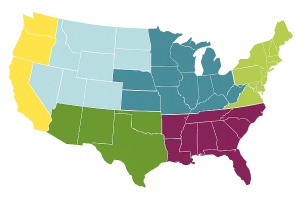Maryland Native Plants, State Flower & State Bird
Posted By American Meadows Content Team on Sep 27, 2012 · Revised on Oct 26, 2025

Knowing your location helps us recommend plants that will thrive in your climate, based on your Growing Zone.
Posted By American Meadows Content Team on Sep 27, 2012 · Revised on Oct 26, 2025
Native plants are adaptable, low-maintenance, and beautiful. They are the best choice for habitat-friendly gardens and thriving ecosystems. Find top picks for native plants in your state - and learn about your state bird and state flowers!
Follow Along With More Of Our Guides
Hello native plant enthusiasts! In the list below, you will find popular native plants and wildflower seeds, available from American Meadows, that have a native distribution in your state. You’ll also find information about your state bird, state flower, and state wildflower!
Grow our Native Northeast Wildflower Seed Mix
Virginia Bluebells (Mertensia virginica)
Showy Goldenrod (Solidago speciosa)
Wrinkleleaf Goldenrod (Solidago rugosa)
Perennial Lupine (Lupinus perennis)
Black Eyed Susan (Rudbeckia fulgida)
Black Eyed Susan or Gloriosa Daisy (Rudbeckia hirta)
Butterfly Weed (Asclepias tuberosa)
Swamp Milkweed (Asclepias incarnata)
Common Milkweed (Asclepias syriaca)
White Trillium (Trillium grandiflorum)
Red Trillium (Trillium erectum)
Painted Trillium (Trillium undulatum)
Long Beaked Sedge (Carex sprengelii)
White Tinged Sedge (Carex albicans)
Appalachian Sedge (Carex appalachia)
Wild Strawberry (Fragaria virginiana)
Lowbush Blueberry (Vaccinium angustifolium)
Plains Coreopsis (Coreopsis tinctoria)
Pink Coreopsis (Coreopsis rosea)
Lanceleaf Coreopsis (Coreopsis lanceolata)
Wild Bergamot (Monarda fistulosa)
Wild Geranium (Geranium maculatum)
Elderberry (Sambucus canadensis)
Phlox divaricata (Woodland Phlox)
Phlox subulata (Creeping Phlox)
Obedient Plant (Physostegia virginiana)
Red Cardinal Flower (Lobelia cardinalis)
Blazing Star (Liatris spicata)
Meadow Anemone (Anemone canadensis)
Anise Hyssop (Agastache foeniculum)
Bottlebrush Grass (Elymus hystrix)
Muhly Grass (Muhlenbergia capillaris)
Big Bluestem (Andropogon gerardii)
Little Bluestem (Schizachyrium scoparium)
Tufted Hair Grass (Deschampsia cespitosa)
Northern Sea Oats (Chasmanthium latifolium)
Yellow Prairie Grass (Sorghastrum nutans)
Smooth Blue Aster (Symphyotrichum laeve)
Aromatic Aster (Symphyotrichum oblongifolium)
New England Aster (Symphyotrichum novae-angliae)
Common White Yarrow (Achillea millefolium)
Helenium (Helenium autumnale) (naturalized in New England)
Heliopsis (Heliopsis helianthoides)

Baltimore Oriole ~ Icterus galbula
Even in the 17th century, American colonists marveled at what is still one of the most popular birds in the United States -- The Baltimore Oriole. They called it the "fiery hang-nest." The distinctive song of the Baltimore Oriole has fascinated many over the years. Ornithologist Alexander Wilson heard in its notes the "pleasing tranquility of a careless ploughboy, whistling for his own amusement." And Henry Thoreau, always an imaginative man, heard it as "Eat it, Potter, eat it!"
Black-Eyed Susan ~ Rudbeckia hirta
Although it is the state flower of Maryland, the Black-Eyed Susan was originally a native of the western prairies. But it has spread so extensively that there is hardly a region in the entire country where its bright yellow petals and "black eyes" are not a familiar sight The Black-Eyed Susan is a member of the Compositae, a hearty family that includes more than a tenth of the world's flowers. The success in the Black-Eyed Susan's colonization of the United States is due to the way the flowers are massed in the heads. This structure ensures a high degree of cross-pollination, for a single insect can fertilize several blooms at the same time.
From The Wildflowers of the 50 States U.S. stamps issued July 24, 1992:

